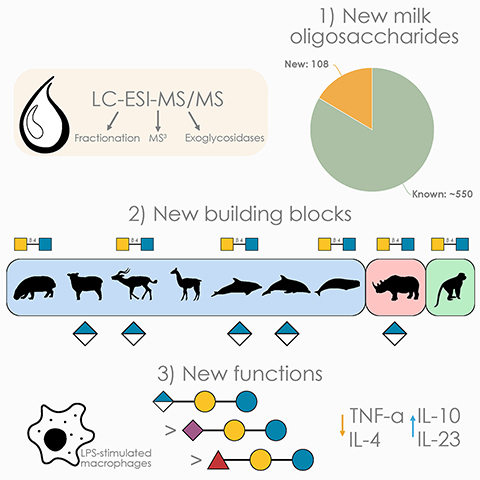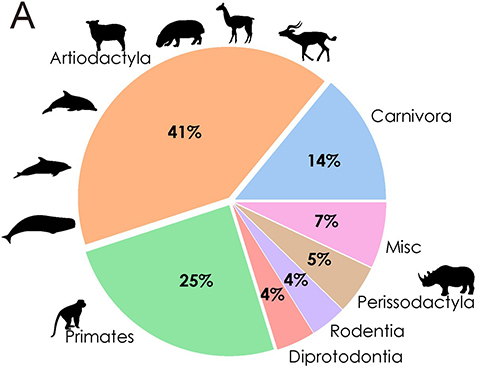Breast milk from rhinos and dolphins and whales, oh my!
A recent study has uncovered that the components of breast milk from land and sea mammals possess immunomodulatory components that may promote healthy microbiome colonization in offspring. These findings could inform efforts to develop better formula for human and animal infants.

The American Academy of Pediatrics and the World Health Organization recommend that mothers exclusively breastfeed their babies for the first six months of life, because it promotes infant survival and a healthy immune system. However, less than 30% of infants are breastfed, due to a variety of reasons such as maternal health and lack of support and resources. Therefore, there is a need to develop formula that more accurately mimics breast milk to promote the health of future generations.
According to Daniel Bojar, an assistant professor of chemistry and molecular biology at the University of Gothenburg in Sweden, scientists need to know more about nonhuman breast milk. Bojar oversaw the new study, which was published in the journal Molecular & Cellular Proteomics.
“For nearly all mammals, we have shallow or zero knowledge about what makes up their breast milk sugars,” Bojar said. “Knowledge from these species can shed light on human milk and therapeutic opportunities. Ultimately, this story is about the amazing things that nature has created and how we are just beginning to unlock their secrets. It's a tale of discovery, of nature's wonders and of the universal bond between mothers and their children.”
Bojar and colleagues examined breast milk from nine understudied mammal species: alpaca, beluga whale, black rhinoceros, bottlenose dolphin, impala, L'Hoest's monkey, pygmy hippopotamus, domestic sheep and striped dolphin. They found that the collective mammalian breast milk contained more than 100 novel milk sugars, including glucuronic acid, and these sugars were shared across species. According to Bojar, glucuronic acid is also found in cartilage and connective tissues.

After identifying these new milk sugars, Bojar’s team wanted to know what purpose they serve. The team exposed macrophages, an immune cell responsible for ingesting foreign invaders, to glucuronic acid-containing milk sugars and observed how it influenced the macrophage behavior and activation. Glucuronic acid dampened macrophages’ inflammatory response to bacteria, indicating that this milk sugar could help prevent excessive immune activation, common in autoimmune diseases, and promote healthy microbiome development in infants.
“We showed that these special sugars are advisers that help the baby's immune system make better decisions,” Bojar said. “In particular, these new molecules seem to aid in the development of the infant microbiome by allowing the good kind of bacteria to colonize the infant gut.”
Bojar said his team’s future work will focus on further dissecting the novel milk sugars found in these mammals and others. He said the findings could be beneficial for creating better human formula that promotes a healthy microbiome.
“Understanding these ‘super ingredients’ can lead to exciting possibilities, such as creating better baby formula or finding new ways to strengthen our immune systems,” Bojar said. “By understanding the powerful properties of breast milk across different animals, we can potentially design better infant formulas that mimic some of these beneficial qualities. For many babies who cannot be breastfed for various reasons, this could be a game changer.”
Enjoy reading ASBMB Today?
Become a member to receive the print edition four times a year and the digital edition monthly.
Learn moreGet the latest from ASBMB Today
Enter your email address, and we’ll send you a weekly email with recent articles, interviews and more.
Latest in Science
Science highlights or most popular articles

The science of staying strong
Muscles power every movement, but they also tell the story of aging itself. Scientists are uncovering how strength fades, why some species resist it and what lifestyle and molecular clues could help preserve muscle health for life.

Bacteriophage protein could make queso fresco safer
Researchers characterized the structure and function of PlyP100, a bacteriophage protein that shows promise as a food-safe antimicrobial for preventing Listeria monocytogenes growth in fresh cheeses.

Building the blueprint to block HIV
Wesley Sundquist will present his work on the HIV capsid and revolutionary drug, Lenacapavir, at the ASBMB Annual Meeting, March 7–10, in Maryland.

Gut microbes hijack cancer pathway in high-fat diets
Researchers at the Feinstein Institutes for Medical Research found that a high-fat diet increases ammonia-producing bacteria in the gut microbiome of mice, which in turn disrupts TGF-β signaling and promotes colorectal cancer.

Mapping fentanyl’s cellular footprint
Using a new imaging method, researchers at State University of New York at Buffalo traced fentanyl’s effects inside brain immune cells, revealing how the drug alters lipid droplets, pointing to new paths for addiction diagnostics.

Designing life’s building blocks with AI
Tanja Kortemme, a professor at the University of California, San Francisco, will discuss her research using computational biology to engineer proteins at the 2026 ASBMB Annual Meeting.

